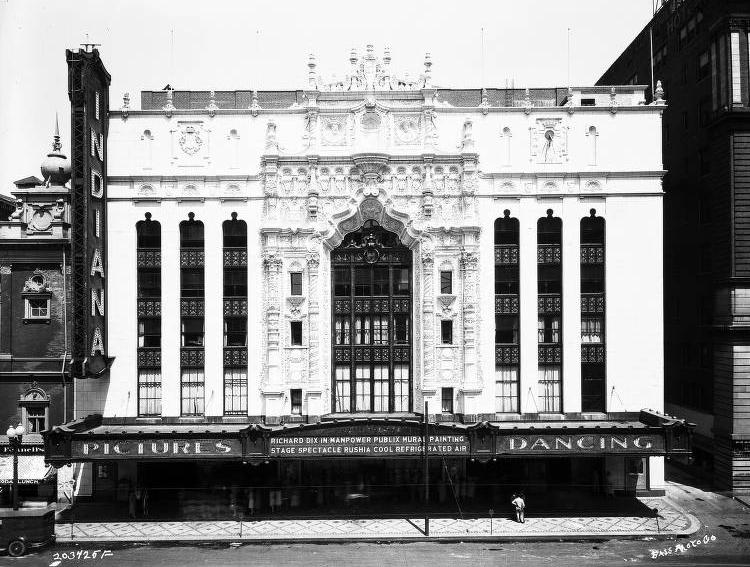In 1927, the Circle Theatre Company, which owned the on Monument Circle, built the Indiana Theatre on West Washington Street as a movie palace. The Spanish Baroque theatre was designed by the Indianapolis architectural firm of . The F. E. Gates Marble and Tile Company, an Indianapolis-based company that had been in business since the mid-19th century, supplied travertine marble and terra cotta of the finest glaze and used sculptor Alexander Sangernebo‘s design for facade ornament. The total cost of construction was $995,000.

The building’s design and ornamentation harken back to the work of the late 17th– and early 18th-century Spanish architect José de Churriguera. This excessively ornated and decorated style came to be known as Churrigueresque. The firm of William Herman & Sons prepared all the plasterwork, including friezes, figures, and ceiling panels, as well as custom woodwork and furniture. Joseph Wollenberg designed the interior decoration.
The six-story concrete frame structure has side and back walls of red brick and a south facade of glazed white terra cotta tile divided into three bays. The marquee, at mezzanine level, extends the entire width of the facade. Above the marquee, simple side bays flank a central one decorated with a high-relief churrigueresque ornament. The entrance lobby features travertine marble walls and floors and an elaborate plaster ceiling.
Beyond the entrance lobby, the two-and-one-half-story main lobby, with vaulted ceiling and mezzanine promenade, extends the full width of the building. The west end of the lobby contains a multitiered fountain of green Rookwood tile, set in a mirrored niche framed by a Moorish arch.
The freestanding grand stairway at the east end of the lobby rises to the mezzanine. Indiana artist painted a large mural of the Taj Mahal that faces its landing. Originally, the Indiana Theatre contained a luncheonette, soda fountain, bowling alleys, billiard rooms, candy, tobacco, and barber shops, and a 3,200-seat auditorium, the largest cinema ever built in Indianapolis.
When it opened on September 2, 1927, the Indiana Theatre represented the height of technology. The building’s unique “weather system” made it one of the first structures in Indianapolis to feature air conditioning. In the ballroom, a “sea breeze” was provided for dancers by passing outside air over iced saltwater in the summer and warmed saltwater in the winter. The resilient dance floor used a suspension system.
The top floor of the building houses the Indiana Roof Ballroom. The ballroom resembles a Spanish town plaza, with a promenade arcade one step above the dance floor. A balcony with a simple iron railing surrounds this composition. The deep blue elliptical domed ceiling is studded with small electric “stars.” Four projectors created “clouds” which moved across the ceiling, adding to the effect of a night sky.

The Roof was a popular venue for dancing for over 40 years, especially during the 1940s and 1950s. Some of the most famous musicians of the big band era performed there including Tommy Dorsey, Louis Armstrong, Cab Calloway, Benny Goodman, and Guy Lombardo. In 1952, the Pop series also made its debut at the Roof. The popularity of the Roof declined in the 1960s. The ballroom served as a place to hold large meetings while the was under construction. When the new facility opened in 1972, the Roof closed.
The Indiana Theatre was the first theatre in the state to adopt stereophonic sound, Panavision, 3-D projection, closed-circuit television, and Cinerama facilities. In the early 1970s, the Indiana and the Circle theatres were the only cinemas that remained in operation in the .
The theatre ceased operation as a cinema in 1975 but was acquired by the (IRT). It reopened in 1980, although it was heavily altered. The main auditorium was gutted and replaced by three smaller performance spaces. The theater continues to be the home of the IRT. is also is in residence.
The Roof finally was renovated and reopened in 1986. Singer Tony Bennett performed at the grand reopening. It remains a popular event and wedding venue.
The Indiana Theatre is listed on the National Register of Historic Places (1979) and the Historic American Buildings Survey.

Help improve this entry
Contribute information, offer corrections, suggest images.
You can also recommend new entries related to this topic.